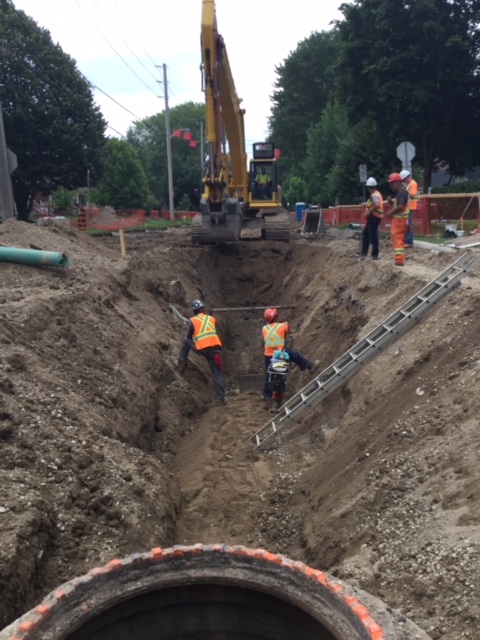Trench safety and inspection is covered in Ontario’s Construction Regulations (O. Reg 213/91) part III sections 222-242. A trench is any excavation that is longer than it is wide. Trenches can be shallow or deep, narrow or wide, long or short. Workers entering a trench must only do so when the trench complies with the act. In order to be compliant, a trench must be inspected.
When does a trench need inspecting?
A trench must be inspected when a worker will be in the trench to ensure compliance. S224 requires a trench to be compliant with the Regulations prior to a worker entering the trench. If no worker will need to be in the trench, there is no specific need to inspect it.
In a situation where the trench is ‘following’, that is being dug at one end and filled in at the other simultaneously, best practice is to have a supervisor assigned to monitor the trench conditions.
What are you looking for?
The safety of a trench is directly related to the type of soil in the excavation. Section 226 details what constitutes the four basic soil types, Type 1 being the best/safest and Type 4 being the least compact and least safe. After determining the type of soil, the slope of the trench walls is the next most important item to check. The slope is determined by the type of the soil, but if unsure, 3:1 out to deep is a good rule. For every meter of depth, the wall should slope out 3m. Ensure that no materials are stored within 1m of the edge of the excavation.
If the trench walls are stable, the next level of inspection is the inside of the trench. The wording in the Regulations is “reasonably free of water” which is open to interpretation, but the less water and mud in the bottom, the safer the trench is (S. 230). The trench must be clear of loose rock or any material that may slide, roll or fall upon a worker (sec 232.1). This can mean by absence or control such as wire mesh.
If the trench has a support structure in it (such as trench box or shoring), the structure must be installed to manufacturer’s specifications or be set according to the regulations (S235, 236, 237, 238). The support structures must also be inspected regularly. The type of inspection and documentation is laid out by the manufacturer, or the quality of the timber and security of installation must be checked and recorded.
If the trench includes utilities or services, ensure that all services are clearly marked and isolated or revealed. All utility locate documents must be current.

How should the inspection be documented?
As with all things related to safety, documentation is key to success. A form that allows the inspector to document soil type, slope, shoring, and other considerations should be made available. Ideally, this form should be electronic that can allow photos to be taken to qualify the findings of the inspection. learn more about digital documentation here
Where can you learn more?
There is more to trench safety than meets the eye. Training in trench safety can be done in person (ideally on a jobsite with trenches) or remotely here
